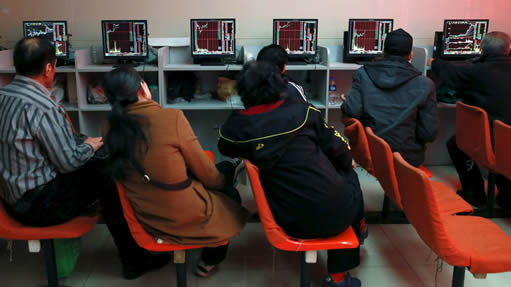导读:今年,在谈到中国经济形势时,有一个词汇经常出现,“L形走势”。今年,《人民日报》两次刊登权威人士访谈,都说到今后中国经济将呈现“L”形走势, “L”形走势到底意味着什么?

An phrase has popped up this year in Chinese economy talk: “L-shaped growth.” In January, an interview with an “authoritative figure” appeared in the People’s Daily, the communist party’s mouthpiece. “China’s economy is unlikely to achieve a V-shape rebound, but instead an L-shape growth,” the anonymous figure said.
今年,在谈到中国经济形势时,有一个词汇经常出现,“L形走势”。一月份,在中共喉舌《人民日报》上刊登了一篇对权威人士的访谈。这位不知名字的人士称,中国经济不可能实现“V形反转”,相反,中国经济的走势应该是“L形”。
The phrase returned to the pages of the People’s Daily May 9, this time with an “authoritative insider,” who insisted that “Chinese economic movements will not be ‘U-shaped,’ let alone ‘V-shaped,’ but ‘L-shaped’.”
在5月9日的《人民日报》上,这个词汇再次出现。这次有一名权威内部人士坚持称,中国的经济发展轨迹不会是“U形”,更别提“V形”,中国经济应该是“L形”。
It’s unclear who this insider is, or if it is the same person in both interviews, but the widespread dissemination of his, her or their views across state media suggests that “L-shaped growth” is now a relatively mainstream concept within the party. “The Q&A with the insider receives lots of attention, since the ‘authoritative insider’ is presumed to be high-level officials”.
我们并不清楚这名内部人士是谁,或者这两次访谈是不是同一人。但是,这次访谈在国内媒体广泛传播,说明这在共产党内部已经达成共识。这种和内部人士的问答式访谈吸引了广泛关注,因为,大家都猜测这名权威人士应该是中国高级官员。
This is the latest inscrutable official or semi-official indication of where the Chinese economy is headed, a matter of ever-growing concern to the rest of the world. China’s sudden devaluation of the yuan last year, for example, caused other currencies to move and left investors confused.
这则中国官员或者准官员做出的,关于中国经济走势的扑朔迷离的解释,这也是现在世界各国关注的话题。比如,去年,中国人民币突然贬值,就造成了其他货币波动,也让投资者很困惑。
Missing from all the interviews is any answer to the question of what “L-shaped growth” actually means. Is the “L” upright, which might suggest economic stagnation? Lying on its back, implying a rapid, hockey-stick recovery? Or even a steep drop-off, like ┐?
在这些访谈中,全都没有给出什么是L形走势的答案。如果L形是立起来的话,是否意味着中国经济将会经历停滞状态?如果是躺倒的话,是否意味着曲棍球棒效应式的陡然增长?或着是反过来的,一次急剧下跌。
Usually, an “L-shape” in economic analysis applies to a precipitous drop or contraction—normally in a recession—followed by a painfully slow and gradual recovery. Japan’s “lost decade” is the most commonly used example of an L-shaped recession recovery.
通常来说,在经济学分析中,L形指的是陡峭的下降,或者是经济萧条期,随后又紧跟着缓慢的经济复苏。日本“失去的十年”是提到“L形”经济最常用的例子。
But China has had no such drop, only a gradual slowdown. What’s more, the Chinese economy is not in recession. Growth remains above 6%, according to official figures.
但是,中国并没有类似的下跌,仅仅是缓慢地下滑。更重要的是,中国的经济并没有处于大萧条。根据官方数据。中国经济增速仍然处于6%。
based on recent history, the most likely interpretation of the “L-shape” claim is that it is mainly about the horizontal line at the bottom of the “L”—meaning growth is going to remain steady after the decline of recent years, but will not take on a “U” or “V” trajectory to return to the double-digit levels of yore.
根据近期的历史,“L走势”最可能的解释是,最核心的内容是L中的那一横,意味着在近些年的下降之后,经济将会保持平稳,不会变成U或者V形轨迹,恢复到往昔的双位数增长。
Of course, this assumes that the “L” is in a relatively normal “L” position and has not been significantly rotated. But it might be in China’s interests to be a little less enigmatic about what its “L” stands for.
当然,此种猜测是L的形态是一种正常形态,没有任何旋转。但对于L到底象征什么,如果能不那么神秘,可能会更符合中国的利益。







